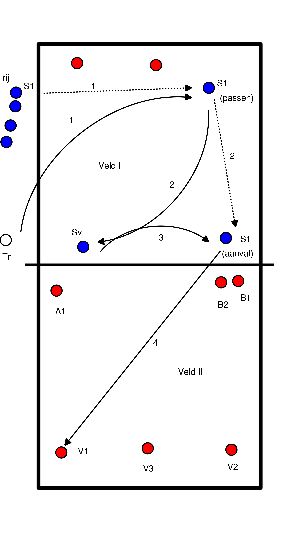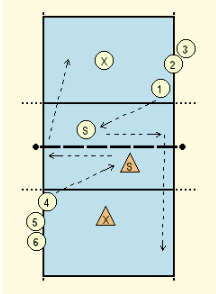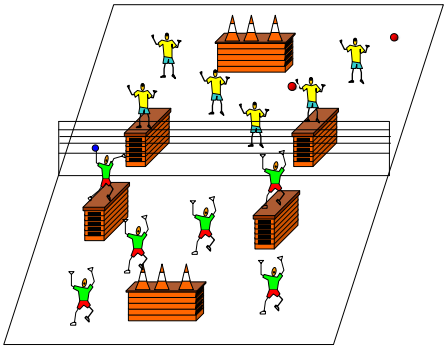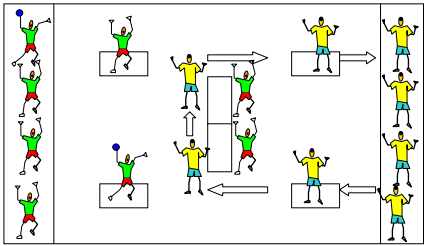Volleyball drills
1) running (on stockings
) 2) stretching
1) Shoulder pumps2
) T-Y-90/90 exo (arms lifted outstretched)
3) planks 1'
4) superman 16x5
) deadbug6
) planks 1'
- 30 sec jumping jacks
- 30 sec sit ups
- 30se squats
- 30 sec push up and turn arm up
- 30 sec high knee running in place
- 30 sec lunges
- 30 sec plank
Warming up / all-round training
Each player will pass, attack, distribute, block, defend, rally, with turnovers.
#2 means
- Trainer stands with cart with balls at the pole at #2 (position 2)
- Players stand outside the field at the side of #1 and a playmaker at # 2/3
- First round starts with Trainer throwing the ball to #5, player 1 runs from the sideline to the ball and plays it to the distributor.
- Start with "blue players" (see drawing), then extend with "red players
Further course of play:
- Tr throws ball for S1 to #5
- S1 runs in and plays to Sv (#2/3)
- Sv gives setup to the outside (#4)
- S1 attacks.
- Turn over: S1 becomes Sv, Sv gets the ball and joins the line at #1.
Expansion 1
- Sv turns to the other side of the net and becomes a blocker.
Now the same steps as above, but with the block opposite the attacker. - Turn over: S1 (has just attacked) becomes Sv at #2/3, Sv
passes under the net and becomes B1 at #2B1
who, after blocking, goes to get the ball and joins the row.
Extend 2
- After blocking at #2, player goes to defend at #5. Attacker is obliged to pass to #5.
- When the ball is defended a rally may be played (2 vs. 2)
- After end of rally or no defence or fault in attack, turn over
Extend 3 and more
- One can extend with a 2nd blocker, 2nd and 3rd defender (on resp. #1 and #6)
- More players can be added to field I (so players from the sideline move in when a rally arises)
- The passing game becomes S1 (passing and attacking) -> Sv -> B1 (#3) -> B2 (#2) -> V1 (#1) -> V2 (#6) -> V3 (#5) possibly A2 (#4) and then connect again.
- You can expand to 6 against 6, so start with blue, then B1, then B2, then V1, then V2 (when continuing the game, first V2 and then V1), then V3 (continuing the game with V2, V3, V1) and then possibly A1. In the meantime, players in field I must be added.
- If there are several players in Area I, you can choose to throw in a ball on S1 at #5 instead of throwing in a ball through Tr.


- The purpose of the exercise is twofold:
- the defender must learn to "read" where the attacker is going to hit
- and the attacker has to see where the defence stands before hitting.
- We work with two regular playmakers, on both sides of the field a row of attackers on the left-for position.
- And two defenders, who may choose where they position themselves on the field.
- A defender has to defend the attack 10 times, preferably a nice pass, but touching is enough.
- If the attacker hits the net or leaves the field, that also counts.
- And the attackers may only smash, no prick balls!
- After the attack, the attacker retrieves the ball and joins the other line.
- When the defender has defended a ball 7 times, he changes with an attacker.
- If there are less players, the exercise can also be done, but then on one side.
- The attacker retrieves the ball and then joins the same line.
- The blocking player joins in and indicates where he is going to block and the mid-back goes to his place.
- In the field there is a team formation.
- After each service rally finish and turn around a spot, so everyone knows his place.
- After that a game of 6 against 4.
Line walk around the field.
Players stand divided on the long side line of the field and start with a quiet run around the field. After 3 laps of quiet running in, they each get an assignment. They carry out the assignment on the short sides of the field and walk on the long sideline at a steady pace.
- connecting pass, sideways
- cross pass
- knee lift
- Heels - buttocks
- Turn right arm forward
- Left arm forward
- right arm backwards
- backward left arm
- sideways shuffle
- attack passes and smash move
Ankles, knees, hips, shoulders, neck, wrists loosen up
Abdominal exercises: 1 minute per part
- Sit-ups, quickly up, hold for a moment and then slowly back down
- right elbow up to left knee and vice versa at a very slow pace
- with ball from left to right
- with ball from feet to head
- planking on hands, ball under you from left to right
- mountainclimbers
- hip cross over
- scorpion
Throwing in on 2 fields with 4-5 players per field.
Symmetrical throw with both hands, throw into the hands of the player and stand still before throwing.
- Throw from the neck high ball
- throw from the neck tight ball
- throw with punch from chest high ball
- throw with a punch from the chest tight ball
- throw with right
- throw with left
- throw with bounce
- Overhead play
- Underhand
- One side overhand, other side underhand
- Free play to each other
- In today's top basketball we can see that the two-handed pass from above the head is frequently used.
- It is therefore important that we stimulate the players to use this pass in certain situations.
- Jumping up on the couch,
- then jump off high,
- down on his knees and
- then jump up high again
- The 2 throwers stand on the boxes and the attackers walk on the ground.
- The throwers and attackers try to knock over the pylons or throw off attackers at the opposing team.
Rules:
- You are not allowed to defend your pylons, you can use chalk to make a circle in which the pupils are not allowed to stand.
- As a thrower and as a declarer you can choose to aim at the declarer or at the pylons.
- The defender is not allowed to fend off but if he catches the ball the thrower is out and a new thrower has to come in
- When a player is thrown out, he/she has to sit on the waiting bench, when a pylon of the opposing team is knocked down, all the keepers can go in again.
- Throwers cannot be thrown off.
- When the opponent's pylons have been knocked down, you have won the game, or when all of the opponents' helpers have been removed.

- Divide the group into two teams.
- From both teams 2 children stand on the mats belonging to their team.
- Also 2 children per team stand in front of the cupboard, these are the goalkeepers.
- The children who stay over, go to the throwing square (see drawing).
- When the balls come into play, the children in the box are supposed to throw the balls against the cupboard.

- In pairs with 1 ball and with the net in between.
- On a 3 meter line and serve calmly to each other.
- Throwing up and concentration.
- Same but increase the distance.
- If it goes well then increase the distance again.
- When both players are behind the backline, serve 5 times good.
After that butterfly:
service, reserve, pass, catch







